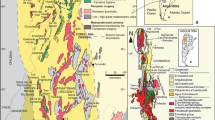Abstract
Wairakei hydrothermal field is underlain by an acid volcanic sequence consisting of the following units: Recent pumice cover, Wairakei Breccia, Huka Falls Formation, Haparangi Rhyolite, Waiora Formation, Waiora Valley Andesite, Wairakei Ignimbrites, Ohakuri Group. The stratified volcanic sequence is draped over a basement horst and thickens eastward and westward into adjoining volcanotectonic depressions. These major depressions have grown progressively during the Quaternary by differential subsidence along active faults and were not the direct result of collapse following major ignimbrite and rhyolite eruptions. The bulk of the steam production is obtained from a thick aquifer of pumice breccias (Waiora aquifer), which is capped by lacustrine shales of the Huka Falls Formation. The best production is obtained from fault zones intersecting the lower part of this aquifer. The Ohakuri Group, underlying the Wairakei Ignimbrites, constitutes a lower, pumice breccia aquifer, not yet directly exploited by drill-holes.
Hydrothermal water at 265°C is fed from the lower to the upper aquifer through linear fissures in the Wairakei Ignimbrites, principally at the cress of a small structural dome. These fissures are related to active, north-east striking, normal faults, having a small dextral transcurrent component. Major zones of heat liberation have been localised at the intersection of secondary, north-west cross faults. Fossil, hydrothermal, mud-flow, conglomerates intercalated in the mid-Pleistocene Huka Falls Formation, suggest that hydrothermal activity at Wairakei is at least 500,000 years old. Isopachs on the early Pleistocene Waiora Valley Andesite indicate that the andesite plug and associated flows were crupted at the same fault intersections, now controlling heat flow into the Waiora aquifer. The inferred great age of the hydrothermal system poses problems in maintaining heat flow, and a model of a large, semi-permanent granitic batholith leaking super-critical hydrothermal fluids up active fault zones to heat near-surface aquifers of meteoric water is proposed. Temperature and pressure equilibria of such a magma body may be maintained by gaseous diffusion. Structural and heat flow evidence suggest that the most probable location of the magma body is to the south of the hydrothermal field below a large, late Pleistocene, rhyolitic eruptive centre.
Other hydrothermal fields in the Taupo Volcanic Zone — Orakeikorako, Waiotapu and Kawerau — have similar geological sequences and structures to Wairakei. Important features in common include:
-
1)
Proximity to a late Pleistocene, rhyolitic eruptive centre typified by ignimbrites, non-welded ash flows and rhyolite domes and sills, which is considered to directly overlie a large, semipermanent magma chamber.
-
2)
A stepped aquifer system comprising alternating permeable pumice breccia or fractured andesite and rhyolite aquifers separated by low-permeability mudstones, ignimbrites and rhyolites.
-
3)
Regional dip of the stratified volcanic sequence towards the rhyolitic eruptive centre, and the presumed source.
-
4)
A conjugate fault system comprising north-east striking, major faults (dextral-normal) and north-west striking, cross faults (sinistral-normal), the interference between the two sets producing open fissures favouring the ascent of hydrothermal fluids.
-
5)
A direct association of zones of maximum heat liberation with structural domes and horsts, often indicated on gravity evidence.
-
6)
Spatial association with flows and plugs, often of andesite or dacite, related apparently to the same fault system.
Similar content being viewed by others
Author information
Authors and Affiliations
Additional information
Paper read at the IAV International Symposium on Volcanology (New Zealand), scientific session of Nov. 29, 1965.
Rights and permissions
About this article
Cite this article
Grindley, G.W. Geological structure of hydrothermal fields in the taupo volcanic zone, New Zealand. Bull Volcanol 29, 573–574 (1966). https://doi.org/10.1007/BF02597177
Issue Date:
DOI: https://doi.org/10.1007/BF02597177




